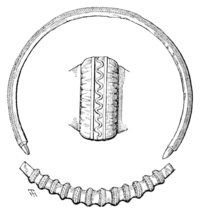Æsculapius this form is particularly mentioned; in this case probably adopted because the serpent was the living emblem of the god. Among the Celts, who never adopted animal forms for their ornamentation, the bulbous termination undergoes several changes. It is found solid and massive, probably to act as a counterpoise, and retain the torques on the neck. Now it is peculiar to the progress of all art, that massive forms, either for the sake of structural beauty or economy of material, are gradually succeeded by lighter ones retaining all the essentials of the type. Hence the bulb became either reduced in size to a mere termination, or else, when preserved, exhibited a form varying from a concave hemisphere to a hollow cone[1]. I would propose this explanation of the motives of a simple people with due deference to the more recondite and learned hypotheses hitherto given. The hollow conical termination is Celtic, but not peculiar to the torques.
Beaded torques. Some of the torques found in England and Ireland are evidently imitations of a row of coarse or large beads threaded upon a thick string and tied round the neck. It will be remembered that the most primeval barrows occasionally contain rude beads of opaque glass with undulating lines, commonly called serpents' eggs, or else of a thick rough porcelain, sometimes reeded externally. When a transition took place to a higher degree of civilization among the Celts, and the art of smelting metals became known, the stone weapons and ruder decorations of those races seem to have been replaced by metallic ornaments, still preserving their original type. The most remarkable torc of this kind is that belonging to Mr. Sedgwick of Skipton, and found lying upon two upright stones under a horizontal stone at the side of the hills between Embsay and Barden. This torc, which was exhibited on the
- ↑ Some varieties of the solid torques exist on the consular coins; see those of the Manlian family already cited; on a reverse of the Papian family, inscribed LPAPI, with the type of a Gryphon, and on another of the Calpurnian family, inscribed L.PISO FRVGI, we find a solid and penannular torques. All these differ much from the solid Celtic torques hitherto found, and indeed rather resemble earrings. Denarii of these types exist in the collection of the British Museum, as well as in that of Mr. Nightingale, who has forwarded me impressions of his coins.

